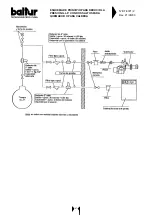
33
NOTES ON USE OF PROPANE (L.P.G.)
We think it would be useful to inform you on a few points regarding use of liquid propane gas (L.P.G.).
1) Approximate evaluation of running costs
a)
1 m
3
of liquid gas in gaseous state has heating power inferior by about 22.000 Kcal.
b)
to obtain 1 m
3
of gas about 2 Kg of liquid gas are required. This is equal to about 4 litres of liquid gas.
According to the above, it can be deduced that by using liquid gas (L.P.G.) the following approximate equivalence
is obtained:
22.000 Kcal = 1 m
3
(in gaseous state) = 2 Kg of L.P.G. (liquid) = 4 litres L.P.G. (liquid). From this, running costs
can be calculated.
2) Safety measures
Liquid gas (L.P.G.) has, in it gaseous state, a specific gravity superior to that of air (specific gravity of propane gas in
relation to air = 1,56) and therefore does not disperse in air like natural gas, which has a lower specific gravity
(specific gravity of natural gas in relation to air = 0,60), but precipitates and spreads at ground level as if it were a
liquid. In view of the above principle, the Ministero dell’Interno ( Home Office) has set limitations for use of Liquid Gas
in circular n° 412/4183 of 6 February 1975. We will look into the points we think most important:
a)
Liquid Gas (L.P.G.) for burners and/or boilers can only be used in rooms above ground and overlooking open
spaces. Installations using liquid gas in basements or cellars are not permitted.
b)
Rooms where liquid gas is used must have ventilation inlets without closing devices, located on external walls
with a surface of at least 1/15 of the room’s area and a minimum of 0,5 m
2
.
At least one third of the entire surface of these inlets must be located in the lower part of the external wall, flush
with the floor.
3) Requirements for liquid gas plant to ensure correct operation and safety
Natural gasification, from cylinder unit or tank, can only be used for low power plant. Supply capacity at gaseous
stage, depending on tank dimensions and minimum external temperature, is shown in the following table but only as
a rough guide.
Minimum
temperature
- 15 °C
- 10 °C
- 5 °C
- 0 °C
+ 5 °C
Tank 990 l.
1,6 Kg/h
2,5 Kg/h
3,5 Kg/h
8 Kg/h
10 Kg/h
Tank 3000 l.
2,5 Kg/h
4,5 Kg/h
6,5 Kg/h
9 Kg/h
12 Kg/h
Tank 5000 l.
4 Kg/h
6,5 Kg/h
11,5 Kg/h
16 Kg/h
21 Kg/h
4) Burner
The burner must be ordered specifically for use with liquid gas (L.P.G.) so that it is equipped with gas valves of
sufficient dimensions to ensure correct ignition and gradual regulation.
Our valves have dimension is planned for use at a supply pressure of about
300 mm.W.C. We suggest gas pressure be checked at the burner by using a water column pressure gauge.
N.B.
Maximum and minimum burner pressure (kcal/h) obviously remains that of the original natural gas
burner (L.P.G. has heating power superior to that of natural gas. Therefore, in order to burn fully, it
requires air quantity in proportion to the thermal power created).
5) Combustion control
To limit consumption and avoid serious trouble, adjust combustion by using the appropriate instruments.
It is absolutely essential to check that the percentage of carbon monoxide (CO) does not exceed maximum
permitted value of 0,1 % (use a phial analyser or other similar instrument). Please note that our guarantee
does not cover burners operating on liquid gas (L.P.G.) in plant for which the above measures have not been
taken.
















































